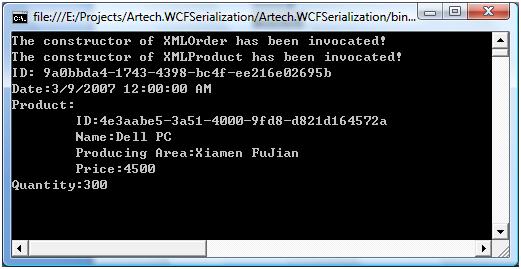XMLSerializer
提到XMLSerializer,我想絕大多數人都知道這是asmx采用的Serializer。首先我們還是來看一個例子,通過比較Managed Type的結構和生成的XML的結構來總結這種序列化方式采用的是怎樣的一種Mapping方式。和DataContractSerialzer Sample一樣,我們要定義用於序列化對象所屬的Type——XMLOrder和XMLProduct,他們和相面對應的DataContractOrder和DataContractProduct具有相同的成員。
using System;
using System.Collections.Generic;
using System.Text;
namespace Artech.WCFSerialization
{
public class XMLProduct
{
Private Fields#region Private Fields
private Guid _productID;
private string _productName;
private string _producingArea;
private double _unitPrice;
Constructors#region Constructors
public XMLProduct()
{
Console.WriteLine("The constructor of XMLProduct has been invocated!");
}
public XMLProduct(Guid id, string name, string producingArea, double price)
{
this._productID = id;
this._productName = name;
this._producingArea = producingArea;
this._unitPrice = price;
}
#endregion
Properties#region Properties
public Guid ProductID
{
get { return _productID; }
set { _productID = value; }
}
public string ProductName
{
get { return _productName; }
set { _productName = value; }
}
internal string ProducingArea
{
get { return _producingArea; }
set { _producingArea = value; }
}
public double UnitPrice
{
get { return _unitPrice; }
set { _unitPrice = value; }
}
#endregion
}
}
using System;
using System.Collections.Generic;
using System.Text;
namespace Artech.WCFSerialization
{
public class XMLOrder
{
private Guid _orderID;
private DateTime _orderDate;
private XMLProduct _product;
private int _quantity;
Constructors#region Constructors
public XMLOrder()
{
this._orderID = new Guid();
this._orderDate = DateTime.MinValue;
this._quantity = int.MinValue;
Console.WriteLine("The constructor of XMLOrder has been invocated!");
}
public XMLOrder(Guid id, DateTime date, XMLProduct product, int quantity)
{
this._orderID = id;
this._orderDate = date;
this._product = product;
this._quantity = quantity;
}
#endregion
Properties#region Properties
public Guid OrderID
{
get { return _orderID; }
set { _orderID = value; }
}
public DateTime OrderDate
{
get { return _orderDate; }
set { _orderDate = value; }
}
public XMLProduct Product
{
get { return _product; }
set { _product = value; }
}
public int Quantity
{
get { return _quantity; }
set { _quantity = value; }
}
#endregion
public override string ToString()
{
return string.Format("ID: {0}\nDate:{1}\nProduct:\n\tID:{2}\n\tName:{3}\n\tProducing Area:{4}\n\tPrice:{5}\nQuantity:{6}",
this._orderID,this._orderDate,this._product.ProductID,this._product.ProductName,this._product.ProducingArea,this._product.UnitPrice,this._quantity);
}
}
}
編寫Serialization的Code.
static void SerializeViaXMLSerializer()
{
XMLProduct product = new XMLProduct(Guid.NewGuid(), "Dell PC", "Xiamen FuJian", 4500);
XMLOrder order = new XMLOrder(Guid.NewGuid(), DateTime.Today, product, 300);
string fileName = _basePath + "Order.XmlSerializer.xml";
using (FileStream fs = new FileStream(fileName, FileMode.Create))
{
XmlSerializer serializer = new XmlSerializer(typeof(XMLOrder));
using (XmlDictionaryWriter writer = XmlDictionaryWriter.CreateTextWriter(fs))
{
serializer.Serialize(writer, order);
}
}
Process.Start(fileName);
}
調用上面定義的方法,生成序列化的XML。
<?xml version="1.0" encoding="utf-8"?>
<XMLOrder xmlns:xsi="http://www.w3.org/2001/XMLSchema-instance" xmlns:xsd="http://www.w3.org/2001/XMLSchema">
<OrderID>b695fd18-9cd7-4792-968a-0c0c3a3962c2</OrderID>
<OrderDate>2007-03-09T00:00:00+08:00</OrderDate>
<Product>
<ProductID>23a2fe03-d0a0-4ce5-b213-c7e5196af566</ProductID>
<ProductName>Dell PC</ProductName>
<UnitPrice>4500</UnitPrice>
</Product>
<Quantity>300</Quantity>
</XMLOrder>
這裡我們總結出以下的Mapping關系:
Root Element被指定為類名。
不會再Root Element中添加相應的Namaspace。
對象成員以XML Element的形式輸出。
對象成員出現的順利和在Type定義的順序一致。
只有Public Field和可讀可寫得Proppery才會被序列化到XML中——比如定義在XMLProduct中的internal string ProducingArea沒有出現在XML中。
Type定義的時候不需要運用任何Attribute。
以上這些都是默認的Mapping關系,同DataContractSerializer一樣,我們可以通過在Type以及它的成員中運用一些Attribute來改這種默認的Mapping。
Root Element名稱之後能為類名。
可以在Type上運用XMLRoot,通過Namaspace參數在Root Element指定Namespace。
可以通過在類成員上運用XMLElement Attribute和XMLAttribute Attribute指定對象成員轉化成XMLElement還是XMLAttribute。並且可以通過NameSpace參數定義Namespace。
可以在XMLElement或者XMLAttribute Attribute 通過Order參數指定成員在XML出現的位置。
可以通過XmlIgnore attribute阻止對象成員被序列化。
基於上面這些,我們重新定義了XMLProduct和XMLOrder。
using System;
using System.Collections.Generic;
using System.Text;
using System.Xml.Serialization;
namespace Artech.WCFSerialization
{
public class XMLProduct
{
Private Fields#region Private Fields
private Guid _productID;
private string _productName;
private string _producingArea;
private double _unitPrice;
#endregion
Constructors#region Constructors
public XMLProduct()
{
Console.WriteLine("The constructor of XMLProduct has been invocated!");
}
public XMLProduct(Guid id, string name, string producingArea, double price)
{
this._productID = id;
this._productName = name;
this._producingArea = producingArea;
this._unitPrice = price;
}
#endregion
Properties#region Properties
[XmlAttribute("id")]
public Guid ProductID
{
get { return _productID; }
set { _productID = value; }
}
[XmlElement("name")]
public string ProductName
{
get { return _productName; }
set { _productName = value; }
}
[XmlElement("producingArea")]
public string ProducingArea
{
get { return _producingArea; }
set { _producingArea = value; }
}
[XmlElement("price")]
public double UnitPrice
{
get { return _unitPrice; }
set { _unitPrice = value; }
}
#endregion
}
}
using System;
using System.Collections.Generic;
using System.Text;
using System.Xml.Serialization;
namespace Artech.WCFSerialization
{
[XmlRoot(Namespace = "http://artech.wcfSerialization/Samples/Order")]
public class XMLOrder
{
private Guid _orderID;
private DateTime _orderDate;
private XMLProduct _product;
private int _quantity;
Constructors#region Constructors
public XMLOrder()
{
this._orderID = new Guid();
this._orderDate = DateTime.MinValue;
this._quantity = int.MinValue;
Console.WriteLine("The constructor of XMLOrder has been invocated!");
}
public XMLOrder(Guid id, DateTime date, XMLProduct product, int quantity)
{
this._orderID = id;
this._orderDate = date;
this._product = product;
this._quantity = quantity;
}
#endregion
Properties#region Properties
[XmlAttribute("id")]
public Guid OrderID
{
get { return _orderID; }
set { _orderID = value; }
}
[XmlElement(ElementName = "date",Order = 3)]
public DateTime OrderDate
{
get { return _orderDate; }
set { _orderDate = value; }
}
[XmlElement(ElementName = "product", Order = 1, Namespace = "Http://Artech.WCFSerialization/Samples/Product")]
public XMLProduct Product
{
get { return _product; }
set { _product = value; }
}
[XmlElement(ElementName = "quantity", Order = 2)]
public int Quantity
{
get { return _quantity; }
set { _quantity = value; }
}
#endregion
public override string ToString()
{
return string.Format("ID: {0}\nDate:{1}\nProduct:\n\tID:{2}\n\tName:{3}\n\tProducing Area:{4}\n\tPrice:{5}\nQuantity:{6}",
this._orderID,this._orderDate,this._product.ProductID,this._product.ProductName,this._product.ProducingArea,this._product.UnitPrice,this._quantity);
}
}
}
重新進行一次Serialization。我們可以得到下面的XML。
<?xml version="1.0" encoding="utf-8"?>
<XMLOrder id="9a0bbda4-1743-4398-bc4f-ee216e02695b" xmlns="http://artech.wcfSerialization/Samples/Order" xmlns:xsi="http://www.w3.org/2001/XMLSchema-instance" xmlns:xsd="http://www.w3.org/2001/XMLSchema">
<product id="4e3aabe5-3a51-4000-9fd8-d821d164572a" xmlns="Http://Artech.WCFSerialization/Samples/Product">
<name>Dell PC</name>
<producingArea>Xiamen FuJian</producingArea>
<price>4500</price>
</product>
<quantity>300</quantity>
<date>2007-03-09T00:00:00+08:00</date>
</XMLOrder>
分析完XMLSerializer的Serialization功能,我們照例來分析它的反向過程—Deserialization。下面的Deserialization的Code。
static void DeserializeViaXMLSerializer()
{
string fileName = _basePath + "Order.XmlSerializer.xml";
XMLOrder order;
using (FileStream fs = new FileStream(fileName, FileMode.Open))
{
XmlSerializer serializer = new XmlSerializer(typeof(XMLOrder), "http://artech.WCFSerialization/Samples");
using (XmlDictionaryReader reader = XmlDictionaryReader.CreateTextReader(fs, new XmlDictionaryReaderQuotas()))
{
order= serializer.Deserialize(reader) as XMLOrder;
}
}
Console.WriteLine(order);
Console.Read();
}
調用DeserializeViaXMLSerializer,得到下面的Screen Shot。下面顯示的Order對象的信息和我們利用DataContractSerializaer進行Deserialization是的輸出沒有什麼兩樣。不過有趣的是上面多出了兩行額外的輸出:The constructor of XMLProduct has been invocated! The constructor of XMLOrder has been invocated。而這個操作實際上是定義在XMLProduct和XMLOrder的默認(無參)構造函數裡的。所此我們可以得出這樣的結論——用XMLSerializer進程Deserialization,會調用的默認(無參)構造函數來初始化對象。

DataContractSerializer V.S.XMLSerializer
上面我們分別分析了兩種不同的Serializer,現在我們來簡單總結一下他們的區別:
特性 XMLSerializer DataContractSerializer 默認Mapping 所有Public Field和可讀可寫Property 所有DataMember Filed、Property 是否需要Attribute 不需要 DataContract DataMember或者Serializable 成員的默認次序 Type中定義的順序 字母排序 兼容性 .asmx Remoting Deserialzation 調用默認構造函數 不會調用